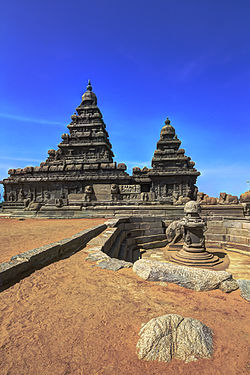 | |
 | |
| Total population | |
|---|---|
| c. 1.20 billion
(61.1% of the total South Asian population)[a] | |
| Regions with significant populations | |
| 1,148,930,682 (2022)[1][b][8][9][10][11] | |
| 24,931,944 (2022)[2][c][12] | |
| 13,130,109 (2022)[13][3][14][15] | |
| 5,198,570 (2022)[4][d][17][18] | |
| 2,921,627 (2022)[5][e][19][20] | |
| 191,778 (2022)[6][f] | |
| 50 (2021)[21] | |
| Religions | |
| Hinduism Tribal religions (including Sarnaism, Nanakpanthi, Kalasha and others) (minority) | |
| Scriptures | |
| Bhagavad Gita and Vedas also see other Hindu texts | |
| Languages | |
| Predominant spoken language Hindi Recognized regional languages Sacred language Sanskrit (Sacred) and Old Tamil[22] | |
Hinduism is the largest religion in South Asia with about 1.2 billion Hindus, forming just under two-thirds of South Asia's population.[a][b][c][d][e][f][23] South Asia has the largest population of Hindus in the world, with about 99% of all global Hindus being from South Asia.[24] Hinduism is the dominant religion in India and Nepal and is the second-largest religion in Bangladesh, Pakistan, Sri Lanka, and Bhutan.[25]
Indo-Aryan migrations brought the Indo-Aryans to South Asia,[26] where they compiled and composed the Vedic corpus during the Vedic period (ca. 1500-500 BCE) across present-day Northern India, Pakistan and Afghanistan.[27] The subsequent period, between 800 BCE and 250 BCE, was "a turning point between the Vedic religion and Hindu religions", and a formative period for Hinduism, Jainism and Buddhism. The Epic and Early Puranic period, from c. 250 BCE and 500 CE, saw the onset of the Hindu synthesis, followed by the classical "Golden Age" of India (c. 350 - 650 CE), which coincides with the Gupta Empire. [28]
Following the conquest of Islamic rulers in the Indian subcontinent and spread of Islam in South Asia, an era featuring persecution of Hindus began and continued until the end of Mughal Empire.[A] The Vijayanagara and Maratha Empire significantly protected and revived Hinduism in the Indian subcontinent, while the Jaffna Kingdom and Gorkha dynasty have significantly protected Hinduism in Sri Lanka and Nepal respectively.[28]
- ^ a b c "India People and Society". The World Factbook. Retrieved 3 August 2022.
- ^ a b c "Nepal People and Society". The World Factbook. Retrieved 3 August 2022.
- ^ a b "Bangladesh People and Society". The World Factbook. Retrieved 3 August 2022.
- ^ a b c "Pakistan People and Society". The World Factbook. Retrieved 3 August 2022.
- ^ a b c "Sri Lanka People and Society". The World Factbook. Retrieved 3 August 2022.
- ^ a b c "Bhutan People and Society". The World Factbook. Retrieved 3 August 2022.
- ^ "Afghanistan People and Society". The World Factbook. Retrieved 3 August 2022.
- ^ "Can Muslims surpass Hindus in population numbers? Experts say practically not possible". 24 April 2022.
- ^ "The Future of World Religions: Population Growth Projections, 2010–2050". Pew Research Center. 1 January 2020. Archived from the original on 22 February 2017. Retrieved 22 February 2017.
- ^ "Központi Statisztikai Hivatal". Nepszamlalas.hu. Retrieved 2 October 2013.
- ^ "India's religions by numbers". The Hindu. 26 August 2015 – via www.thehindu.com.
- ^ "Nepal". US Department of State.
- ^ "Census 2022: Bangladesh population now 165 million". 27 July 2022.
- ^ "Atrocities on Hindus in Bangladesh: Now, 1.8 crore Hindu Bengali citizens of Bangladesh are ready to go to India, said Ravindra Ghosh, Chairman of Bangladesh Hindu Janajagruti Samiti". Retrieved 9 May 2021.
- ^ "Hindu population in Bangladesh grew by 1 per cent in 2015: Report". The Economic Times. 23 June 2016. Retrieved 16 June 2021.
- ^ "SALIENT FEATURES OF FINAL RESULTS CENSUS-2017" (PDF). Retrieved 3 August 2022.
- ^ "Hindus under the official Muslims of Pakistan". 17 July 2020.
- ^ "Religion wise population, Pakistan". Government of Pakistan. Archived from the original on 19 July 2014.
- ^ "A3 : Population by religion according to districts, 2012". Census of Population & Housing, 2011. Department of Census & Statistics, Sri Lanka.
- ^ "Census of Population and Housing 2011". Department of Census and Statistic. Retrieved 13 October 2019.
- ^ Country Policy and Information Note: Afghanistan: Hindus and Sikhs (PDF). Home Office, United Kingdom (Report). 6.0. March 2021. p. 15. Retrieved 17 May 2021.
- ^ Johnson, Todd M.; Grim, Brian J. (2013). The World's Religions in Figures: An Introduction to International Religious Demography (PDF). Hoboken, NJ: Wiley-Blackwell. p. 10. Archived from the original (PDF) on 20 October 2013. Retrieved 24 November 2015.
- ^ "Region: Asia-Pacific". Pew Research Center's Religion & Public Life Project. 27 January 2011. Retrieved 16 June 2021.
- ^ Pechilis, Karen; Raj, Selva J. (2013). South Asian Religions: Tradition and Today. Routledge. ISBN 978-0-415-44851-2.
- ^ "Hindus". Pew Research Center's Religion & Public Life Project. 18 December 2012. Retrieved 16 June 2021.
- ^ Flood 1996, pp. 21–23.
- ^ Thapar 1966, p. 23.
- ^ a b Honour & Fleming 2005, p. 123-141.
- ^ Durant 1976, pp. 458–472.
Cite error: There are <ref group=lower-alpha> tags or {{efn}} templates on this page, but the references will not show without a {{reflist|group=lower-alpha}} template or {{notelist}} template (see the help page).
Cite error: There are <ref group=upper-alpha> tags or {{efn-ua}} templates on this page, but the references will not show without a {{reflist|group=upper-alpha}} template or {{notelist-ua}} template (see the help page).
© MMXXIII Rich X Search. We shall prevail. All rights reserved. Rich X Search
